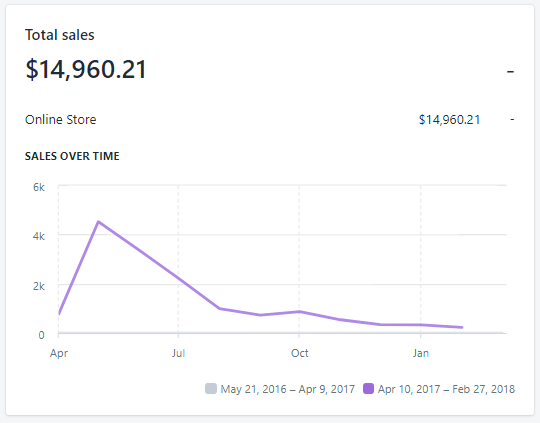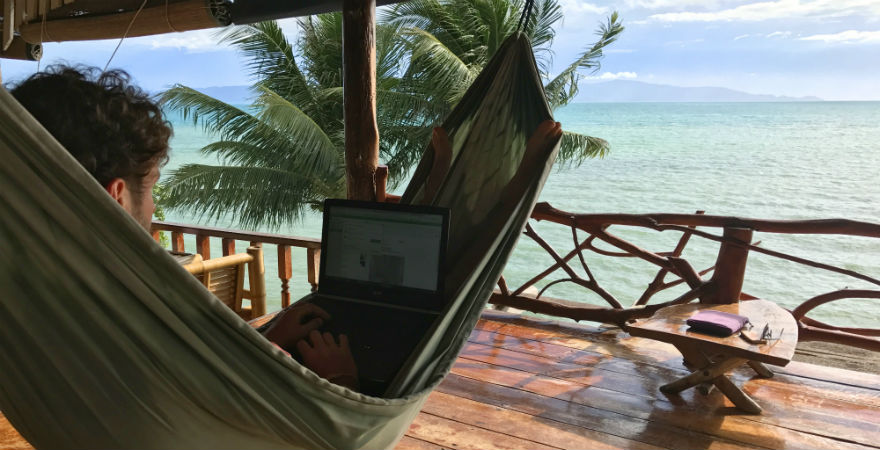When Karolis Rimkus dials into our video call, he’s looking particularly relaxed. It’s early in the morning in Louisiana where he’s dialling in from, so it could be the result of a good night’s sleep. Or, it could be that this is the look of someone who has just spent the last eight months traveling the world.
Karolis, who is from Lithuania, is in the US winding down his journey with his wife. The trip was financed almost entirely with the money he earned with his dropshipping store, which he ran as a side-hustle while working full-time.
For the past seven years, the 9-5 defined Karolis’ life. He worked in media companies and marketing departments, always using his skills to help grow other people’s businesses. “I was always doing a job for someone else, there was nothing of my own that I had,” he says.
Then in early 2017, Karolis and his wife decided to was time to make a change. They hatched a plan together to save enough money so they could quit their jobs and leave for a three month trip around Asia.
Well, in the end, things turned out a little better than that.
Karolis’ business helped him save enough to turn their three-month trip into a eight-month venture that took them around the world. They visited China, Hong Kong, Thailand, Malaysia, Philippines, Indonesia, Laos, Thailand (again), Cambodia, Vietnam, Taiwan, and Japan, and finally ended their travels with a road trip across the United States from LA to New York.
Post Contents
- Early Signs of Entrepreneurship
- How to Make Money Online: Exploring the Options
- Finding a Side-Hustle Routine
- Setting up Shop and Deciding What to Sell
- Building a Store and Getting the First Sale
- Wait, What’s Going Wrong Here?
- This Thing Works! Growing the Success of His Store
- Hitting His Highest Ever Sales Month
- The Life of a Digital Nomad
- Karolis’ Top Tips for Side-Hustling Entrepreneurs:
- Want to Learn More?
Early Signs of Entrepreneurship
Thinking back, there were early indications that Karolis had a future in entrepreneurship. When he was a teenager, he spent time building his own websites, always testing out new ideas that he felt certain would take off.
They were, in the order that he can remember them, a forum for discussing all kind of music, a blog that listed natural disasters, and an elaborate way to make money by funneling website traffic through a series of links. They all tended to fizzle out in the end though.
Still, like all entrepreneurs, he didn’t let past failures get in the way of new ideas, and the itch to start something new has always been there.
How to Make Money Online: Exploring the Options
When the world came calling, Karolis got creative in the ways he could hustle to make some extra money for their trip. He needed to find something he could work on while still holding down his full-time job. Karolis turned to the internet, looking for ways that he could use his skills in marketing to make money online.
He tried affiliate marketing, but it was complicated, time-consuming, and the results were underwhelming. And in the end, he just wasn’t interested in it.
Scrolling Facebook one day, he discovered dropshipping. A friend had posted an article about entrepreneurs who were generating mind-boggling amounts of revenue with their stores. It made him curious. As he started to look into it more, he read about how to use the dropshipping model to build an online store quickly, easily, and with less financial risk.
Dropshipping doesn’t require the store owner to invest in any inventory. The supplier holds onto all of the stock, and the store owner only pays for the item once it’s been sold. Then the supplier will ship it directly to the customer. It’s a fulfillment model that’s used by huge companies like Walmart, Best Buy, and Costco.
For new entrepreneurs and side-hustlers, it’s a business model that works especially well, because it lets you open up a store and test your product ideas within the market, without running the risk of buying up a whole lot of stock that might not sell.
Karolis was looking for a side hustle that he could set up quickly, didn’t require too much financial risk, and one that he could work on in his free time in the evenings and weekends. Dropshipping ticked all the boxes.

Finding a Side-Hustle Routine
For the side-hustler, who only has a limited amount of time to work on their business, finding a good routine is key. From Monday to Friday, Karolis would work at his full-time job as a brand manager, but his Sundays were always reserved for dropshipping.
On Sundays, he’d go back into the office, which was now empty and distraction-free, and spend from the morning to the evening working on his store.
When you’re a side-hustler, the ongoing challenge is juggling competing priorities. Everything and everyone demands your attention. Your full-time gig, your side-business, your friends and family, and your personal interests are all competing for your time and attention.
Although he blocked out Sundays to work on the business, he found that the store quickly consumed a lot of his free time.
“When I got hooked on it, I was thinking about it probably 24/7,” he says.
He admits it was sometimes a difficult sacrifice to make. “Finding spare time to work on the website was challenging. I had to not do anything with my wife on Sundays. I had to skip fun things that people were doing. You really have to be dedicated.”
Setting up Shop and Deciding What to Sell
When he started, Karolis quickly realized that there was so much that he didn’t know. “I had an understanding of how things worked because I worked in marketing, but not how to build a website, how to sell a product, how to source a product,” he says.
To decide what to sell, he looked towards his interests. “I read that people recommend testing out a range of products, and to not fall in love with your products, but I knew that if I were to do something that I didn’t know much about, it would be hard for me.”
So, he chose the one interest that literally got him out of bed in the morning… running.
“I’m an avid runner, I’ve run marathons and races and trained five times a week,” he says.
When you’re beating the pavement with that kind of intensity, you become intimately familiar with the qualities that you need in running gear. With an eye for this kind of quality, he was able to find great products for his store, and separate the best from the rest.
To help find products to sell, he turned to dropshipping. The method would allow him to connect his online store with dropshipping suppliers, pulling in the details of their inventory with the click of a button. He signed up for a Shopify account, installed a dropshipping app, and got to work.
Building a Store and Getting the First Sale
Progress at the beginning was slow. “I had to try a lot of things,” he says, “But really, that’s the interesting part.” Embracing the entire process, through the easy and the difficult moments, is important, he says. “It makes it rewarding when you succeed in a smaller part of the journey, such as nailing the product page.”
Slowly, his store began to come together. He spent time adding new products and tweaking his store’s design. He jumped into marketing, setting up social media accounts on Tumblr, Pinterest, Facebook, and Instagram.
He got creative with his tactics and tried reaching customers where they were hanging out online. “I was going through runners’ forums with my personal profiles, reading people’s concerns about their situation with bad shorts or terrible headbands, and was offering a suggestion on what to improve, and sliding in my products here and there.”
Traffic began to trickle in.
By now, he was two months in to building his store. And yet, no sales. Nothing.
“I was at the point where I thought that this was going to be like every single endeavor of mine in internet marketing, which always failed.”
He was frustrated. Once again he’d spent so much time building something that was doomed to failure.
Wait, What’s Going Wrong Here?
It was time to stop, step back, and take a look at what was happening. If people were coming to his store, but not buying, there had to be something going on that he wasn’t seeing.
He used heat mapping tools to see which areas of his websites customers were spending the most time, and which bits needed tweaking.
“I can’t emphasize enough how many tests with the website I made. My most valuable insights came from hotjar.com, where with just a few dozen customer behaviour recordings you can see what’s wrong with your website and where to improve.”
He changed up his marketing strategy and decided to focus on doing one channel really really well, instead of spreading his effort too thinly across many channels. He doubled down on his Instagram, the channel he was most familiar with. He focused on creating a cohesive look for his content, and establishing relationships with influencers to help promote his products.
And then it happened. All of a sudden… ka-ching!
His first sale.
This Thing Works! Growing the Success of His Store
“It was a very rewarding moment!” he says. And it was just the motivation he needed to keep going.
And as he began to grow his store and sales, Karolis discovered the things that were worth investing his time in:
- Customer service.
- Careful curation and detailed descriptions of products.
- Growing a brand with social media.
Customer service was a big focus for him since the beginning. “I try replying in as few hours as possible, making it easier for people.” He found that he could reduce the number of refund requests with excellent customer service. For anyone requesting a refund, he dealt with their request quickly, politely, and offered them a coupon for their next purchase. This tactic worked, and often ending earning him even more sales.
When it came to products, attention to detail was key. Rather than adding a huge catalog of common, rather ordinary items to his store, he spent hours searching for products, carefully curating only the best quality, best-looking products for his store. He spent time crafting his product descriptions, aiming to provide more information about the products than a customer could find on another website.
To get the word out about his store, Karolis turned to social media. But instead of spending money pumping out ads promoting a business that people hadn’t heard of yet, he focused instead on building a trusted brand.
Karolis tapped into the passionate community of running enthusiasts that were already on Instagram, posting motivational content and advice to help them improve their running practice.
To help his content reach a broader audience, he came up with a creative influencer marketing strategy.
“At first I did a lot of influencer outreach. I would offer micro influencers, people with like 8,000 followers, an item they could make a giveaway with, or just send them a few free items in exchange for mentions. It worked, and I was growing and making sales.”
When his page grew to over 15,000 followers, he switched up his technique. With a powerful audience of his own, he now offered up-and-coming influencers a chance to be profiled on his page. They would buy something from his store, take a photo of themselves wearing it, and he would repost their photo on his profile. This clever win-win tactic turned the table on traditional influencer marketing strategies and helped him boost his sales, his credibility, and his audience all in one hit.

Hitting His Highest Ever Sales Month
As springtime was approaching, and the weather got warmer, Karolis knew that people would start to run more. This meant they’d also be looking at refreshing their running wardrobe. Now was the time to step things up.
He upped his posting schedule on Instagram and Facebook and began to work more extensively with influencers, branching outside of his core market to reach new audiences.
One of his best influencer partnerships surprised him. He contacted a suburban mom blogger who he had noticed was gaining influence on Instagram. While she wasn’t known with the running or fitness scene, she had a loyal following of her own. He got in touch with her and offered to send her free products for her to review. When she received them she posted pictures of her children unwrapping the package on Instagram Stories. Her fans loved it, and trusted her recommendation, and he watched as sales started to pour in.

“Don’t hesitate trying out ideas,” he says. Like his winning influencer, you never know what you might get. “I would not have known if I hadn’t tried it.”
By the end of May, thanks to a killer Instagram strategy and great timing, he’d come away with over $5,000 in sales. Yep.
 Over ten months, Karolis made $14,960 in his store.
Over ten months, Karolis made $14,960 in his store.
The Life of a Digital Nomad

When Karolis and his wife left for their trip in September, the business came along with him. After all, it was generating an average of $2,000 per month in revenue, and by this point, he was only spending a few hours a week working on the business.
In the true style of digital nomad, the whole world became his office. Some days, he’d head to a hammock by the beach, and work in the sunshine with his laptop, the sound of waves crashing in the background.
Other times, it wasn’t so glamorous.
In Ho Chi Minh City, Vietnam, facing an important Skype call, he was forced to build a makeshift workstation in the tiny bathroom of their hotel – the only spot in the entire room with a reliable internet connection and a working power socket.

Of course, an entrepreneur’s curiosity is never really satisfied, so during their trip, he started another side hustle. This time, he was using the social media skills he’d learned from months of trial and error with his own store to help grow other people’s businesses.
In February, with sales of running apparel slowing down during the winter months, and his social media marketing work quickly picking up, he decided to sell his running store. He listed it for sale on the Exchange Marketplace, and sold it–for the equivalent of five months worth of his full-time salary–within a few weeks.
Near the end of our chat, he takes a moment to think back on the impact that starting the dropshipping store has had on his life.
“It fully changed the way I live,” he concludes.
Not only did he make enough money to finance his globe-trotting, but the skills he developed have opened up a future full of new opportunities. With enough work coming in through his social media marketing work, he’s been able to wave goodbye to the 9-5 and work for himself, on his own schedule, from anywhere in the world.

Karolis’ Top Tips for Side-Hustling Entrepreneurs:
- Make it fun. “When you’re enjoying something, it’s easy to find time for it, to be enthusiastic about it, and do your best.” He advises entrepreneurs to focus on a product category they love and on marketing platforms they enjoy using. There are so many different marketing strategies to try, so why not make it fun?
- Choose your work environment carefully. If have only a limited amount of time to work on your business, make sure your time is productive. For him, that meant going somewhere there’s nothing else to do but work. “Even if I’d be home alone, I’d go to a coffee shop, because that’s a place that does not have a fridge for you to be distracted with dinner ideas, it does not have laundry laying around that could be done, or even other people you know that might strike a conversation and distract you.”
- Choose where to focus your time. The reality is, you don’t have the time to do everything. Focus on the things that are most important, and try to outsource the rest. For Karolis, this meant focusing on customer service, social media, and curating high-quality products. As you work on the business, the distinction between what’s important will become clearer. Over time, he says, “You develop the skills to learn what takes time and what to outsource.”

Want to Learn More?
- How This 21-Year-Old Found Winning Products and Grew His Beard Grooming Brand
- How to Travel the World as a Digital Nomad (With No Regrets)
- Dropshipping 101: Ecommerce Without Inventory
- How To Turn Your Hobby Into a Business
- How to Start a Dropshipping Business
